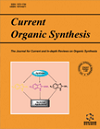- Home
- A-Z Publications
- Current Organic Synthesis
- Previous Issues
- Volume 20, Issue 5, 2023
Current Organic Synthesis - Volume 20, Issue 5, 2023
Volume 20, Issue 5, 2023
-
-
Incorporation of Protecting Groups in Organic Chemistry: A Mini-Review
More LessThe approach of utilizing protecting groups (PGs) in organic chemistry has led to the successful syntheses of an array of useful organic compounds. This strategy has also addressed some of the complexities associated with many organic reactions. These PGs find useful applications in simple and complex reactions that involve the synthesis of large organic compounds such as peptides, and oligosaccharides. The fundamental role Read More
-
-
-
Synthetic Procedures to Access 2-Guanidinobenzazoles of Biological Interest
More LessBenzazoles (Bz) and derivatives are interesting molecules in medicinal chemistry. Several of these compounds display diverse biological activities; some are still used in clinical applications. In this way, synthetic chemists are interested in developing new procedures to access compounds with the guanidine moiety as 2-aminobenzimidazole (2ABI), Astemizole (antihistaminic), Albendazole (anthelmintic) and Carbendazim (fungici Read More
-
-
-
DFT and In-silico Investigations, along with In-vitro Antitumor and Antimicrobial Assessments of Pharmacological Molecules
More LessBackground: Molecules bearing an active methylene bridge are one of the most fruitful and remarkable precursors that have been incorporated into the synthetic strategy of an assortment of bioactive compounds. Objective: The reactive methylene derivatives have been endowed with multiple reactions, which target biological and medicinal applications and result from their structural diversity and discrete reactivity. Me Read More
-
-
-
Microwave-assisted Synthesis of Pharmacologically Active 4-Phenoxyquinolines and their Benzazole-quinoline Hybrids Through SNAr Reaction of 4,7-dichloroquinoline and Phenols Using [bmim][PF6] as a Green Solvent
More LessBackground: Quinoline and its derivatives have been shown to display a wide spectrum of biological properties, especially anticancer activity. Particularly, diverse potent anticancer drugs are based on the 4-phenoxyquinoline skeleton, acting as small-molecules VEGR2 and/or c-Met kinase inhibitors. However, the design of new drugs based on these quinoline derivatives remains a challenge. Up till now, all approaches to 4-p Read More
-
-
-
A New Way to the Synthesis of Tricyclic Compounds via Nitrone 1,3- cycloaddition Dipolar Reaction
More LessAuthors: Nadia Zga, Mounir Azouz and Djamel BouchoukObjective: This study aimed at developing new methodologies for 1,3-dipolar cycloaddition. Methods: A new series of tricyclic derivatives (13a-d) were synthesized via 1, 3-dipolar cycloaddition of nitrones (8a-c) and (9a-c) using intramolecular cyclisation at the reflux of toluene and radical intramolecular cyclisation in the presence of tributyltin hydride and AIBN as an initiator in benzene, which are two techniques to prepare Read More
-
-
-
Design, Synthesis, Molecular Docking, ADMET, and Biological Studies of Some Novel 1,2,3-Triazole Linked Tetrazoles as Anticancer Agents
More LessBackground: 1,2,3-Triazole-tetrazoles have received substantial attention because of their unique bioisosteric properties and an extraordinarily broad spectrum of biological activity, making them interesting for the drug design, and synthesis of a delightful class of widely investigated heterocyclic compounds. To address major health concerns, it is consequently important to devote ongoing effort to the identification an Read More
-
Volumes & issues
-
Volume 22 (2025)
-
Volume 21 (2024)
-
Volume 20 (2023)
-
Volume 19 (2022)
-
Volume 18 (2021)
-
Volume 17 (2020)
-
Volume 16 (2019)
-
Volume 15 (2018)
-
Volume 14 (2017)
-
Volume 13 (2016)
-
Volume 12 (2015)
-
Volume 11 (2014)
-
Volume 10 (2013)
-
Volume 9 (2012)
-
Volume 8 (2011)
-
Volume 7 (2010)
-
Volume 6 (2009)
-
Volume 5 (2008)
-
Volume 4 (2007)
-
Volume 3 (2006)
-
Volume 2 (2005)
-
Volume 1 (2004)
Most Read This Month
Article
content/journals/cos
Journal
10
5
false
en


